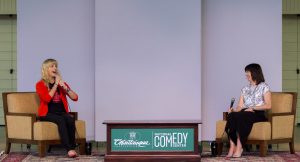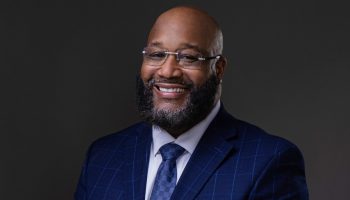
It takes courage to proclaim one’s innermost anxieties to complete strangers, but turning mental illness and existential despair into comically cathartic performances? That takes a lot more than courage; it requires evocative writing, eccentric characters and an abundance of voices. Maria Bamford has, reluctantly, mastered them all.
Bamford, stand-up comedian and actress, spoke at 10:45 a.m. Friday, August 2 in the Amphitheater, closing Week Six, “What’s Funny? In Partnership with the National Comedy Center.” She was interviewed by Ophira Eisenberg, comedian and host of NPR’s and WNYC’s weekly radio game show, “Ask Me Another.”
The first time Bamford hit the stage as a stand-up comedian, she had a violin and a shaved head. Her parents “forced” her to start playing the violin at just 3 years old and said she couldn’t quit until she turned 16.
“Oh boy, I could not wait to get that cock-block out of the way,” Bamford said. “I used it in my act when I started because it helped distract from the fact that people didn’t like my material.”
When she moved to Los Angeles, she was relieved to find two other female comedians who played the violin while performing stand-up, giving her an excuse to finally ditch the act and try something else.
However, the shaved head was there to stay. Bamford said she was bald for ease and because it helped her “blend in with the men.”
“Comedy, at that time, was mostly men,” she said. “When you shave your head, no one is interested in talking to you after your set to tell you what they find funny; they think you’re ill, or perhaps, very angry — both of which are true.”
In the early stages of her career, comedian Frank Conniff suggested Bamford read The Artist’s Way, a book she said taught her to own her craft.
“It very much helped me define what I wanted to do and to start saying ‘I am a comedian,’ ” she said. “I think that half the trick of doing anything is to say that you’re doing it.”
Throughout her career, Bamford’s characters have been inspired by her family. Her mother does it to herself, according to Bamford, as a transcription of her day-to-day comments alone could serve as stand-up material.
“She said to me, ‘Honey, when you don’t wear make-up you look mentally ill,’ ” she said. “That’s just tight, succinct.”
Instead of comedy clubs, Bamford initially preferred performing in arts venues and empty coffee shops.
“If you’re going to do it, go where the love is,” she said. “If you like to fight against the tide, if you like a strip club at 2 a.m. where everyone is angry that you’re there and the nude lady has stopped dancing, then go for it, I tell you, go for it.”
Even now, Bamford is willing to do a show at any time, anywhere.
“I love low expectations,” she said. “But just like any job, you get into it for a specific reason, and I love attention. I love to be amplified and lit.”
Bamford will occasionally tweet her location and offer to perform for anyone who wants to show up. She most recently did that when she was invited to Harvard University to be inducted into The Harvard Lampoon, an undergraduate humor publication and organization founded in 1876.
When she arrived at Harvard, she found out it was more of a party, occupied by young people with red cups and kegs who said “adorable things.”
“(They told me) ‘I just don’t know what I’m going to do after college,’ ” she said. “Do you know where you’re at? You’re at fucking Harvard. Yeah, you’re going to be fine.”
Bamford said Lampoon staff “hazed her” as part of her induction, demanding she tell them what the Lampoon is. Each time they asked, Bamford responded, “I don’t know,” until they eventually told her it was “nothing,” and gave her a medallion. She really just wanted a T-shirt.
“I’m sure someone who is more pleasant as a person would have enjoyed it,” she said. “I am irritable on the whole.”
Her induction was a great accomplishment, but her growth didn’t come without struggle, as Bamford said she has never had a solid mentor. Even Bamford’s parents were typically hands-off with respect to her comedic development — they just wanted her to be healthy.
“I was one of those kids who had mental health problems; I went in and out of the hospital for a little while, so they were just glad that I had a job,” she said.
Bamford has been open about her bipolar disorder and obsessive-compulsive disorder for years. Her Netflix show, “Lady Dynamite,” is based on her time in a psychiatric hospital, and she was awarded the 2014 Illumination Award by the International OCD Foundation for her work spreading awareness about living with mental illness.
She started incorporating mental health into her stand-up after a “breakdown, bipolar episode” in 2011. Bamford said when she was released from treatment, it was “all she could talk about.”
“You have to fill the hour, the time,” she said. “Do everything you can with what you have.”
Bamford said she was never worried about including the personal material because she no longer cared what other people thought of her.
“I was so lonely in that experience that I thought, ‘At least if I tell someone about my own experience, maybe someone else wouldn’t feel as lonely,’ ” she said. “That’s something I love about the comedy community, it’s very generous and it’s a place where you can talk about anything.”
The more she joked about it, the more it became her “schtick.” Fans started bringing prescription bottles for her to sign, which was fitting for Bamford, who said medication changed her life. Currently, she’s on 750 mg of Depakote, an anticonvulsant; 50 mg of Seroquel, an antipsychotic; and 40 mg of Prozac a day.
“It is life-changing,” Bamford said. “Some people aren’t into this; some people are more into, I don’t know, positive thinking, iowaska, I’m not sure. I do have to say, laughter is not the best medicine — medicine is, in fact, the best medicine.”
When Bamford was in a psychiatric ward, one of the therapists recognized her, but said she would never tell anyone that Bamford was in treatment.
“I’m in a county-stamped gown, in a pair of electric green gripper socks that are not my own — you tell whoever the fuck you want, because all is lost,” she said.
Happiness, on the other hand, doesn’t have enough “zing” to be funny. Bamford noted that there are not as many comedy clubs in tropical locations as there are in New York City because there’s “no need.”
As Bamford continued to open up in her career, criticism toward her stand-up became more personal. Bamford said she enjoys making the most of the “heckling” during her shows.
“To heckle passively is to be alive,” she said. “My response to that sometimes is, ‘I know it seems like this isn’t a show to you and it’s not, it’s actually not a comedy show, it’s an intervention — myself and members of the community have all come together to confront you about how you’re a real jackass.’ ”
Bamford said one of her greatest failures starting out was a performance at Tempe Improv in Arizona. At the time, she didn’t have the requested 45 minutes of material, but said yes anyways, because “that’s on them.”
Bamford performed to a silent crowd. Afterward, no one talked to her and she was so embarrassed, she walked along the freeway, violin in hand, to go back to her hotel room and buy a ticket home for that night.
Eisenberg had a similar experience when she went to perform at a college in Erie, Pennsylvania. A Pittsburgh Penguins hockey game was on, and right before the third period, they turned the game off to introduce her. The audience booed and everyone, but one person, left.
“But the check cleared,” Eisenberg said.
To the “irritation of her manager,” Bamford has always been transparent about her contracts and income.
According to her, the payments for opening acts has not increased since she started working. She is currently working on a special where she is earning $275,000. Her opener? $150. Bamford is going to pay her $2,500 for her five-minute set.
Bamford and her husband have $2.2 million in assets, and she makes roughly $250,000 a year.
“It’s kind of awful and I’m not sure how to fight it,” she joked. “My husband and I, we’re atheists, but we are ethically competitive. We heard in most religions, you’re supposed to give 10% of your income away; we’re giving 11%. We don’t even fucking believe in heaven, but we’re going.”
Her alma mater, the University of Minnesota, asked Bamford to deliver a commencement speech, and when she asked them how much she would make, they told her “nothing,” it was an “honor” just to be invited. Bamford countered that with a request for $20,000. Bamford didn’t feel bad — she knew the university had a recent, and very successful, fundraiser where they received $900 million for their new athletic facility, “presumably for the poets.”
“The University of Minnesota was trying to suggest that I could not get paid for the one thing I paid them to teach me how to get paid to do,” she said.
The university followed up with an offer of $10,000, even though she claimed she would’ve done it for $600. Bamford said she felt so guilty, she gave the money away to help some of the students pay off their loans.
“It sounds like a nice thing to do, but that’s the only way I am able to do kind things: if it is in public and it is grandiose,” she said.
Bamford’s candid style has inspired thousands to try stand-up for themselves, including “Sally Love.” Sally, 75, started her stand-up career in January. Bamford asked her to come on stage and perform her bit, which Sally did without hesitation.
In her set, Sally talked about the challenges of online dating, saying men at any age are all the same; they still lie about their age, send unwanted photos and have “chinks in the armor.”
“What we want to see are pictures of their garages, their closets and we want thread count — we really want thread count,” Sally said.
Sally said she wants to create a new dating app that is “a mix of Match and Yelp.”
“We need user reviews,” she said. “If I had known that Stan had 10 guns and watches Fox News on TV all day, I could have saved myself a lot of time.”
Sally did find her knight in shining — but still chinked — armor: Mike, who was in the audience, cheering her on the whole way through.
Bamford and Eisenberg then wrapped up their conversation, providing light commentary on Sally’s performance.
“Wow, I think I might have to tighten up my jokes,” Bamford said.
Editor’s note: Due to time constraints, the lecture did not feature a Q-and-A to close out the morning; not that anything was left unsaid, anyway.




